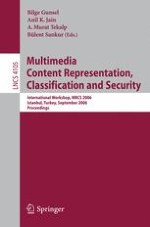We would like to welcome you to the proceedings of MRCS 2006, Workshop on Multimedia Content Representation, Classi?cation and Security, held Sept- ber 11–13, 2006, in Istanbul, Turkey. The goal of MRCS 2006 was to provide an erudite but friendly forum where academic and industrial researchers could interact, discuss emerging multimedia techniques and assess the signi?cance of content representation and security techniques within their problem domains. We received more than 190 submissions from 30 countries. All papers were subjected to thorough peer review. The ?nal decisions were based on the cri- cisms and recommendations of the reviewers and the relevance of papers to the goals of the conference. Only 52% of the papers submitted were accepted for inclusion in the program. In addition to the contributed papers, four distinguished researchers agreed to deliver keynote speeches, namely: – Ed Delp on multimedia security – Pierre Moulin on data hiding – John Smith on multimedia content-based indexing and search – Mar´ ?o A. T. Figueiredo on semi-supervised learning.
